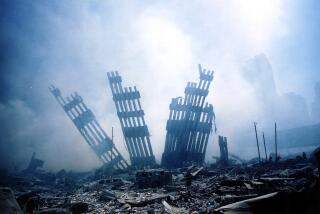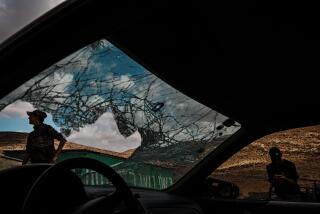To Troops Waiting in the Saudi Desert, the War Is a Surreal Experience : Military: They watch the war on CNN and hear what’s going on via transistor radios.
WITH U.S. FORCES, Saudi Arabia — Armored division soldiers encamped in the desert struggled with their chemical warfare protective gear Friday and listened to the war by transistor radio, a surreal experience that created a sense of disconnection in the front lines.
An aide to the chief of staff for the 1st Armored Division was awakened early Thursday with the news that the war was about to begin, with Tomahawk cruise missiles aimed at Baghdad and a wave of fighter aircraft soon to follow.
The officer, Capt. Wayne Sauer, said his first temptation was to go back to sleep.
“What was I going to do from here?” Sauer said.
“Certainly we’re all very happy that the Navy and the Air Force are taking the lead right now,” said Maj. Guy Swan, assistant division operations officer. “When you start committing the ground forces to the operation, that’s a significant step.”
But the scene was not all sanguine.
At least half an hour expired between the time a first-stage alert was called against a possible Iraqi chemical attack and the time when most soldiers first heard about it.
Officers said later that the division commanding general, Maj. Gen. Ronald H. Griffin, ordered the alert at 5:25 a.m. and the officers and soldiers attached to the tactical operations center immediately put on their protective gear.
But it was not until 6 a.m. that many troops, shivering in foxholes as part of a mandatory alert that began two hours earlier, first learned about the order, after noticing a few patrolling troops wearing the chemical-protective gear. And as late as 8 a.m., some soldiers could still be seen unpacking their sealed garments pouch.
“Let’s just hope it doesn’t take an hour (when it counts),” grumbled one angry sergeant, “That’s why I want to get out of this place,” said another. “These people don’t know what they’re doing.”
Still, some officers expressed skepticism Friday that any Army unit might be on the receiving end of a Scud missile assault. The thousands of American soldiers here sometimes seem swallowed up by the yawning emptiness of the northern Saudi desert. It makes the chance of a Scud hit seem remote.
“If we get hit, it would be by accident,” one officer said.
The soldiers watched the war on CNN and listened to the radio. The network’s first-day coverage was videotaped by a military broadcast unit at a location two hours away and ferried to the front in a move that gave the war here its principle sense of immediacy.
“This thing’s going along too easy,” said one wary soldier, Pfc. Rufus N. Montgomery, 19, of Pensacola, Fla. “One thing we know is he (Hussein) has got to have an ace in the hole.”
The soldiers were shipped in from Germany only last month. The division’s weight of armor and sheer combat power make it likely to be part of a main American striking force against Iraqi troops. Then the soldiers say their main concern is not Scuds, but chemical-laden artillery shells and the killing zones of monumental Iraqi defensive fortifications.
The soldiers grumbled Friday when they were ordered for the first time to don the jackets and trousers of their chemical protective suits.
The protective qualities of the charcoal-lined suits can diminish over time, with the useful life of the garments estimated at two weeks from the time they are removed from sealed packages. While each soldier is issued two such suits, and replacements are expected to become available, the ground troops in this unit clearly regard the suits as a cherished piece of gear that should not be squandered.
“Why start the clock running now when the time we’ll really need it is two weeks from now?” complained one private who insisted that his name not be used.
The soldiers’ own resistance contributed to the considerable delays in complying with the alert order Friday morning. But a communications breakdown was the main culprit.
The division public affairs officer, Maj. Ken Fugett, acknowledged that “the command and control may need some improvement.” He said the problem at headquarters was rooted in the schism between the operations center that houses the division’s top commanders and the company of ordinary soldiers whose job is to support it.
“It’s a matter of human communication,” Fugett said. “All the guys at the center know about it sooner than we do in the periphery.”
The alert was withdrawn later in the morning. But in an indication of continuing concern about further Iraqi night attacks, all soldiers in the division were told to put on the garments again at 5:30 p.m.
Alerted Nov. 9 that it would be deployed to Saudi Arabia, the division is not yet fully in place, with soldiers still waiting at ports in eastern Saudi Arabia. More tanks, artillery and other equipment still stream northward toward the front.
Under military reporting restrictions, the exact location of the headquarters and elements of the 1st Division cannot be disclosed, but it is part of a vast Army VII Corps deployment that has provided the United States with formidable armored combat strength well to the west of positions established by American units that arrived in Saudi Arabia last summer.
Awaiting the arrival of its final units, the 1st Armored Division is now in a tactical assembly area in the far northern part of Saudi Arabia. The division’s nearly 20,000 men and women remain well out of range from Iraqi artillery and most missiles.
The air war is a show for these ground troops, who take delight in spotting Air Force planes as they head southward on what are apparently return trips from Iraq.
This story was reviewed by U.S. military censors.
More to Read
Sign up for Essential California
The most important California stories and recommendations in your inbox every morning.
You may occasionally receive promotional content from the Los Angeles Times.









